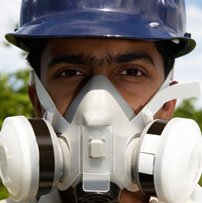A GUIDE TO CHOOSING THE CORRECT RPE
Choosing the correct RPE means adequate RPE which is right for the particular hazard faced and is capable of reducing exposure to the level required to protect the wearer’s health.
To find adequate RPE, employers should first narrow down their options to include only those that are capable of protecting against the particular hazard identified in the initial risk assessment.
These hazards could be particulates, gases, vapours, or some combination of these.
Next, employers should whittle down their options further, to include only RPE that is also capable of protecting against the particular quantity of the hazard present in their workplace.
The HSE gives each RPE type an ‘assigned protection factor’ (APF), denoting the level of protection it offers.
This can be crossed referenced with both the employers risk assessment, if it includes the concentration levels of contaminants found in the workplace, and Workplace Exposure Limits published in the HSE’s EH40 document, which can be downloaded free from the organisation’s website.
Minimum APF’s required for certain tasks are often found in HSE guide sheets.
Ensuring RPE is suitable
Suitable RPE is that which is right for the individual wearer, the task and the environment.
When RPE is suitable, it allows the wearer to work freely, without causing additional risks.
Another major benefit of using suitable RPE generally is that wearers are less likely to remove it or wear it incorrectly because they find it uncomfortable, or in order to communicate effectively with one another, particularly if they have to wear it for long periods.
Failing to comply with RPE requirements can reduce or even eliminate the protection provided, leaving the wearer exposed to potential hazards.

ENSURE YOUR RESPIRATOR FITS CORRECTLY
For tight fitting respirators to work, they must form an adequate seal with the wearer’s face.
This applies whether the respirator is disposable or reusable, half face or full face.
If the seal leaks, the wearer risks breathing in unfiltered, potentially hazardous air.
To ensure that a respirator is capable of creating an adequate seal when worn by a particular individual, fit testing is required.
Under the Control of Substances Hazardous to Health (COSHH) Regulations 2002, employers are required to face fit wearers of tight fitting RPE.
It is vital that fit testing is done while the individual is wearing other PPE required in their daily work that may interfere with the respirator seal, such as safety eyewear.
Fit testing should be performed during initial selection, and whenever there is a change that might affect RPE performance.
For example, if the wearer loses or gains a significant amount of weight, or undergoes dental work, the shape of their face may change.
It is also good practice to repeat fit testing periodically.
RPE fit testing may be conducted by a competent person in-house, or by an external service provider.
Accreditation under the British Safety Industry Federation‘s Fit2Fit scheme is a good way to judge the competence of fit testers, although such accreditation is not mandatory.
Additionally, wearers of tight-fitting RPE must be clean shaven under the area of the face seal, as facial hair can compromise the seal.
Alternatively, those with facial hair may wear certain loose-fitting powered and supplied air respirators.
Employers can also consider these options if they wish to avoid face fit testing.
RPE TRAINING
Another important stage of the RPE selection process is training.
Without the correct knowledge, workers may be at risk of unnecessary exposure.
Training should begin with outlining the need for protection in the first place.
Workers must understand why and when RPE is required.
Next, the respirator’s limitations should be explained so that users know what they can and cannot rely on their RPE to protect them against.
Putting on and removing the equipment should also be covered.
This is important as it will affect user acceptance of the RPE, as well as compliance rates.
Where required, maintenance is also a key topic.
Reusable respirators must be properly cleaned and stored between shifts to prevent damage and contamination.
We hope you found our guide on choosing the correct RPE useful.
Do you need quality RPE? Then you’re in the right place. We have a large range to choose from on our website.
Can’t find what you’re looking for? Then give us a call on 0330 0885 675. Or email us at info@totalsitesafety.co.uk
The post A guide to choosing the correct RPE appeared first on Total Site Safety.
